Dive Details
Location
Date
Tuesday 20 November 2018
Time
10:40am - 11:33am
Buddy
Amanda Hay, Matthew Lockett, Kerryn Parkinson, Joey DiBattista
Seas
Some surge
Visibility
3 to 5 metres
Duration
52 minutes
Surface interval
Maximum depth
14.1 m
Average depth
10.4 m
Water temperature
17°C
Dive Profile from Garmin Descent Mk1

Tides at Botany Bay AEDT
Note that tides at dive site may vary from above location.
Low
12:41am
0.42m
High
7:00am
1.52m
Low
1:10pm
0.53m
High
7:08pm
1.47m
Details
Today's dive was with my colleagues from Ichthyology at the Museum. They needed to do a refresher dive but also wanted to see some of the fish I see on a regular basis.
The tide was quite low and it was calm so we were able to get in easily. We swam out on the surface and when we were all ready, we descended. On the bottom the visibility was between 3 and 5 metres. The water temperature was around 18°C. There wasn't much surge and the current was barely noticeable.
I started looking around for the orange Red-fingered Anglerfish with dark eyes. As the visibility was not great, half the task was to find the rock where I'd seen it on Saturday. I managed to find the rock and the anglerfish was exactly where it was on Saturday. After taking a few photographs I pointed it out to the others.
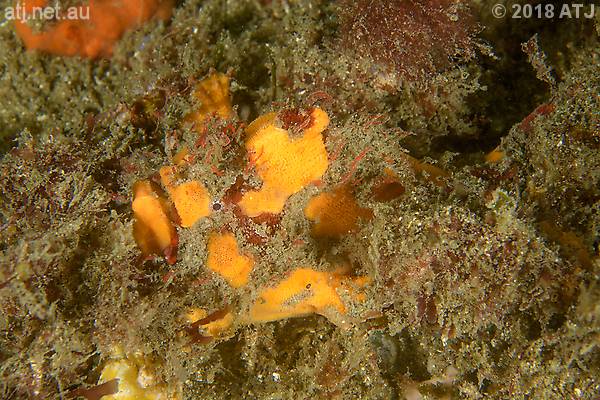
Red-fingered Anglerfish, Porophryne erythrodactylus. 9.6m.
I swam on to the seahorses with my entourage in tow. I found "Jodi", the yellow female Pot-bellied Seahorse, straight away. She was on one of the purple sponges between the rocks. I pointed her out and started looking for "Stephen". Kerryn found him before I did and he was low down on the outside of the kelp covered rock.

Female Pot-Bellied Seahorse, Hippocampus abdominalis, ("Jodi"). 10.8m.
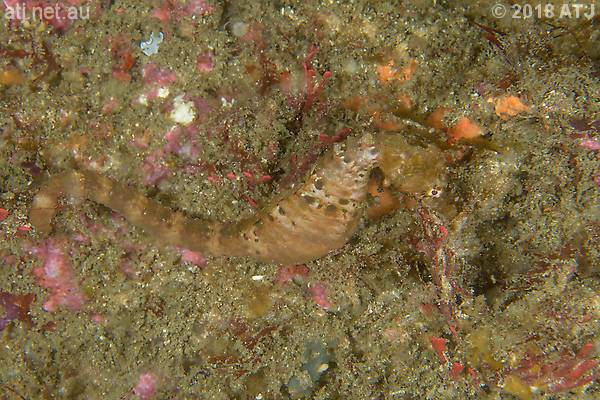
Male Pot-bellied Seahorse, Hippocampus abdominalis, ("Stephen"). 11.5m.
We swam along the sand line towards the hole with the pipefishes. I was hoping to see some Weedy Seadragons along the way. I looked into the pipefishes hole and immediately spotted one of the Upside-down Pipefish. I took a couple of photographs and pointed it out to Amanda. She caught a glimpse of it before it disappeared deeper into the hole.
I took them up the reef away from the sand line to the grey Red-fingered Anglerfish. Fortunately, it was in the same spot it has been for the last couple of weeks so I didn't have to search for it. I pointed it out to the others.
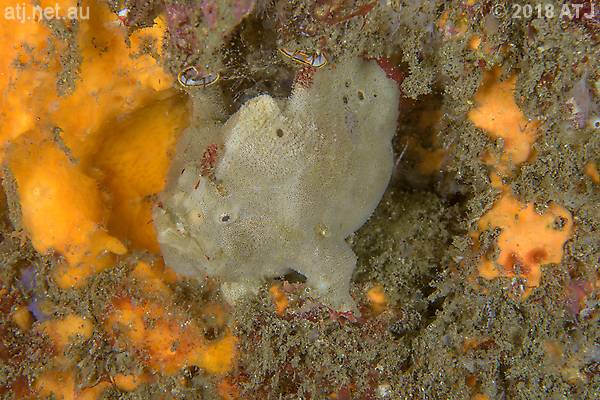
Red-fingered Anglerfish, Porophryne erythrodactylus. 10.1m.
I swam to the large rock behind Little Big Rock for the pygmy pipehorses. I found both of them (IL2018072001, IL2018072002) fairly quickly and pointed them out to the others. They aren't the most attractive pygmy pipehorses, nor are they easy to see because of the angle of the rock but they at least accessible.
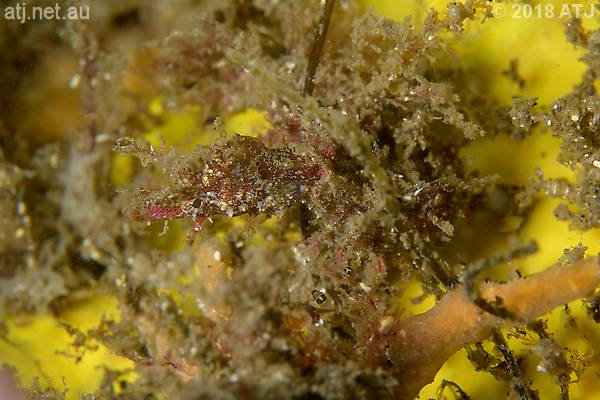
Female Sydney Pygmy Pipehorse, Idiotropiscis lumnitzeri, (IL2018072001). 11.3m.

Male Sydney Pygmy Pipehorse, Idiotropiscis lumnitzeri, (IL2018072002). 11.2m.
We headed to Little Big Rock. I had a look for the large yellow Red-fingered Anglerfish on the way but didn't spot it. The salmon Red-fingered Anglerfish was in its usual spot with its eggs. The anglerfish was obscuring the eggs so I couldn't point them out to Amanda.

Red-fingered Anglerfish, Porophryne erythrodactylus. 11.9m.
We headed along the sand line towards Diversity Rock. I was hoping to find the male Weedy Seadragon that had eggs 10 days ago. I suspect he'd have no eggs now. I was not able to find him.
We swam past Diversity Rock and I noticed a male Weedy Seadragon with brand new eggs. It was the same male I'd last seen 10 days ago with the tail of a hatchling hanging out of one of the eggs. I think this might be his third brood of the season. There was also a Clown Toby swimming nearby. I hope the Clown Toby wasn't attempting to eat the eggs.
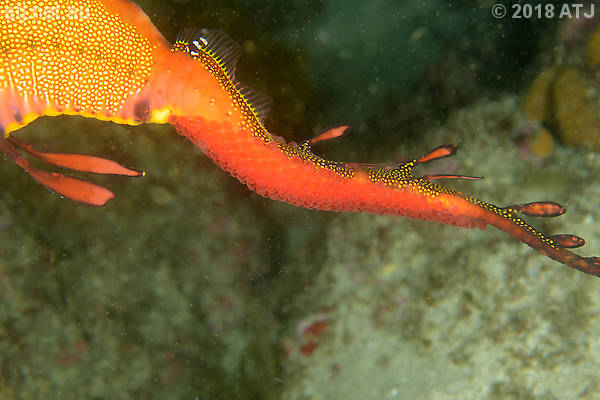
Eggs on the tail of a male weedy seadragon, Phyllopteryx taeniolatus. 12.5 m.

Weedy Seadragon, Phyllopteryx taeniolatus. 12.8m.
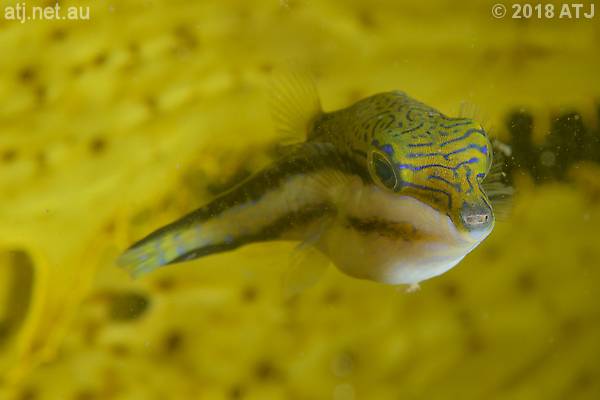
Clown Toby, Canthigaster callisterna. 12.6m.
We made our way almost to Big Rock. I was able to locate the pair of pygmy pipehorses (IL2018102701, IL2018111001) on the substrate below the rock below Hand Rock. I pointed them out to Amanda.
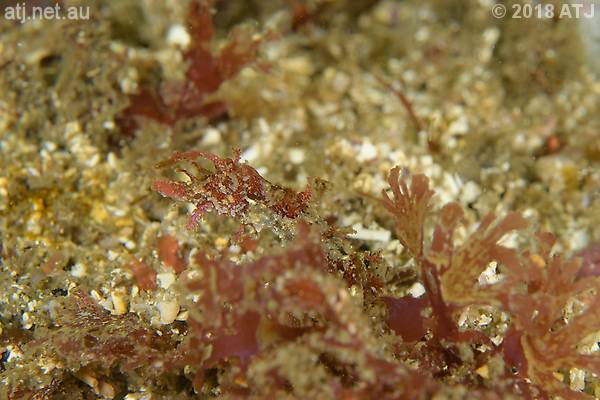
Female Sydney Pygmy Pipehorse, Idiotropiscis lumnitzeri, (IL2018102701). 13.8m.
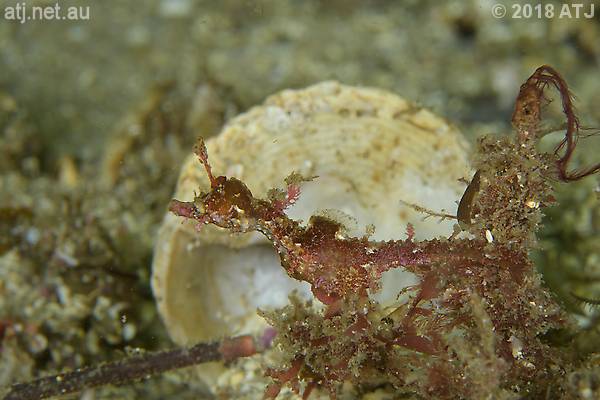
Male Sydney Pygmy Pipehorse, Idiotropiscis lumnitzeri, (IL2018111001). 13.7m.
Matthew was running low on air so we turned around and started to swim back to The Steps. We had to swim into a bit of current but nothing too challenging.
We swam past the basket star and I pointed it out. I also spotted a small Nembrotha sp. nudibranch. I stopped at the grey Red-fingered Anglerfish as we swam through.

Basket star, Astrosierra amblyconus. 11.1m.
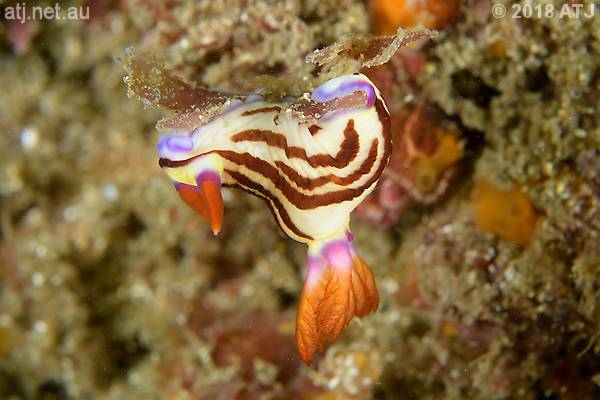
Nudibranch, Nembrotha. 10.8m.
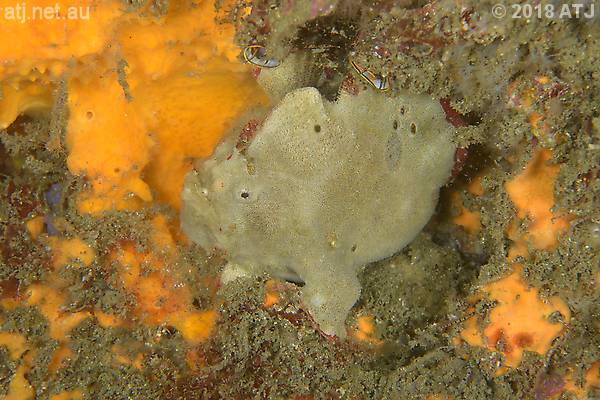
Red-fingered Anglerfish, Porophryne erythrodactylus. 10m.
We ascended to 5 metres and started our safety stops as we swam to Split Rock. We finished our safety stops and then swam to the exit. The tide was low and the exit was easy.
Camera gear
Camera
Nikon D500
Lens
Nikon AF-S Micro Nikkor 60mm f/2.8G ED
Housing
Ikelite 6812.5
Lens port
Ikelite Flat Port 5502.41
Strobe
2 x Ikelite SubStrobe DS161